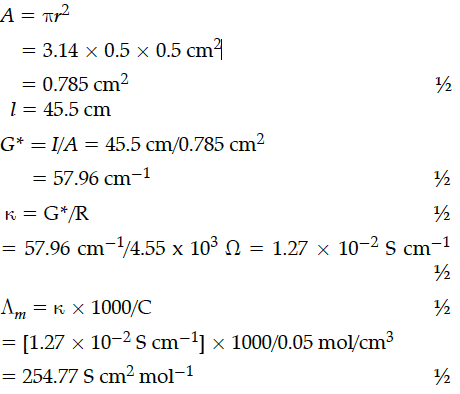The electrical resistance of a column of 0.05 M KOH solution of diameter 1 cm and length 45.5 cm is 4.55 × 10³ ohm. Calculate its molar conductivity.

The conductivity of 0.20 M solution of KCl at 298 K is 0.025 Scm⁻¹. Calculate its molar conductivity.
State Kohlrausch law of independent migration of ions. Why does the conductivity of a solution decrease with dilution ?
The conductivity of a 0.01 M solution of acetic acid at 298 K is 1.65 x 10⁻⁴ S cm⁻¹. Calculate molar conductivity () of the solution.
The potential of a hydrogen electrode at pH = 10 is
a. 0.591 V
b. 0.00 V
c. – 0.591 V
d. -0.059 V
The conductivity of metals decreases while that of electrolytes increases with increase in temperature. Why?
The conductivity of an aqueous solution of NaCl in a cell is 92 \(Ω^{−1}\) \(cm^{-1}\) the resistance offered by this cell is 247.8 Ω . Calculate the cell constant.
Calculate pH of following half-cell. Pt, \(H_2\) / \(H_2\)\(SO_4\) , if its electrode potential is 0.03V.
(i) Complete the following equations :
(a) 2MnO₄⁻ + 5SO₃²⁻ + 6H⁺ →
(b) Cr₂O₇²⁻ + 6Fe²⁺ + 14H⁺ →
(ii) Based on the data, arrange Fe²⁺, Mn²⁺ and Cr²⁺ in the increasing order of stability of +2 oxidation state.
E°(Cr³⁺/Cr²⁺) = -0.4 V
E°(Mn³⁺/Mn²⁺) = +1.5 V
E°(Fe³⁺/Fe²⁺) = + 0.8 V
(i) Account for the following :
(a) Cu⁺ is unstable in an aqueous solution.
(b) Transition metals form complex compounds.
(ii) Complete the following equation :
CrO₂₇²⁻ + 8H⁺ + 3NO₂⁻ →
The magnetic moment of few transition metal ions
are given below:
(i) Give reasons for the following :
(a) Compounds of transition elements are generally coloured.
(b) MnO is basic while Mn₂O₇ is acidic.
(ii) Calculate the magnetic moment of a divalent ion in aqueous medium if its atomic number is 26.
Account for the following :
(i) CuCl₂ is more stable than Cu₂Cl₂.
(ii) Atomic radii of 4d and 5d series elements are nearly same.
(iii) Hydrochloric acid is not used in permanganate titration.
The electrical resistance of a column of 0.05 M KOH solution of diameter 1 cm and length 45.5 cm is 4.55 × 10³ ohm. Calculate its molar conductivity.
Calculate emf of the following cell
Cd/\(Cd^{2+}\) (.10 M)//\(H_+\) (.20 M)/\(H_2\) (0.5 atm)/Pt
[Given E° for \(Cd^{2+}\) /Cd = -0.403V]
